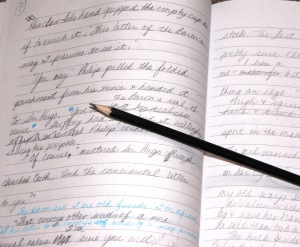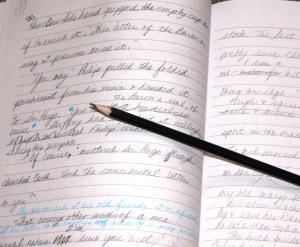
I revisited this blog post from 2010 as I was thinking about the next phase of my current writing project. I still have a few thousand words to go and a major plot point to figure out, but I’m eagerly awaiting typing “The End” and finally getting to the fun stuff. I love revising and editing my work. It means the tough part is over, and now I get to create the story I had in mind when I started. My first hurl of words onto the page is always a struggle. I feel set free once the words are finally down, and I get to play. Below are some self-editing questions that I will ask myself as I go through my work. Maybe some of them will help you, too.
1. Where does the story really begin?
Reread the first two to three pages of your story very carefully. When does the action really start? A major fault with many first drafts (mine, included!) is too much background material at the beginning before the conflict is introduced and the characters finally take over the story. In my case, I can almost bet that my story doesn’t really begin until about half-way down page three, so out go the first two pages. If the material I have cut is essential for the reader to know, I find ways later, through dialogue or thoughts of my characters, to get the information to the reader. My later insertions are never as long as those original two and a half pages and the pace of the story gains needed speed.
2. Is this adverb necessary?
Chances are, if you are using a lot of adverbs, you are telling and not showing. Think about the character that has just won the lottery. Rather than have her yell hurray ‘joyfully’, why not have her jump up and down screaming so loudly that her cat runs under the bed in terror and it takes her twenty minutes to get it out. Maybe she runs to her closet and throws all of her old clothes in the garbage while “If I Had a Million Dollars” blasts in her iPod. Both of those pictures show how the character reacts instead of telling and are certainly livelier than the word ‘joyfully’.
3. Is this adjective doing its job?
Look for those empty adjectives and replace them. ‘Amazing’, ‘interesting’, ‘exciting’, ‘awful’, ‘ugly’, ‘beautiful’, ‘nice’, ‘scary’, and other adjectives like them need to be replaced with sensory details that bring to life what you are describing. Find places to get the readers’ senses working; it means you are making the story real for them.
4. Whose problem is it?
Your main character has the problem; the main character needs to solve it. Make sure that your protagonist remains the chief actor in the story and doesn’t become solely the reactor to another character’s influence. Sometimes in longer pieces, characters other than your lead can start to steal your attention and your imagination; this can be especially true of villains and ‘comic sidekicks’. Be careful that these characters don’t become so charming that they threaten to steal the book from your hero or heroine. (I speak from some experience here. I created a villain in an historical romance that I liked so much, he eventually got his own book!)
5. Are the grammar and spelling perfect?
Yes, I mean perfect. The most that an editor needs to read of a short story in order to make a decision is approximately three paragraphs; a novel might get three pages. If that’s the only chance you have, don’t blow it by showing your lack of ability in spelling and grammar. Of course, publishers have people whose job it is to make sure that the copy they publish is correct in every way, but there’s no way they’re going to waste that person’s time on writers who haven’t bothered to do their best the first time. If you are self-publishing, correct grammar and spelling are key to your work being thought of as professional and being recommended by readers.
6. Have I read my story out loud?
One of your best proofreading tools is the sound of your own voice. Reading your story aloud is a great way to find awkward or incomplete sentences, clumsy phrasing, and inconsistencies in verb tenses and pronoun agreement. If you hesitate when you are reading or if you have to reread a sentence or phrase, then that’s a section of your story that needs a rewrite.
7. Have I applied the Stephen King rule?
Stephen King concludes his autobiography, On Writing: A Memoir of the Craft, with an editing exercise. He shows you the first draft of a story he has written and then shows it again full of his cross-outs, inserts and editing marks. He explains his edits and why he makes the choices he does. King’s revision rule is: “2nd Draft = 1st Draft – 10%.” We have a tendency, as writers, to believe that every word we write is precious and are very reluctant to cut our material–after all, we remember how hard it as to get it down on paper the first time. However, editing is about making our prose lean, and exciting, and compelling the reader to turn the page. See what you can do with ten per cent fewer words.
Consider revision a reward. Remember that if you are revising, you have finished a project–and how neat is that? Try these seven questions to kick-start your editing and begin your pursuit of a great final product. I can’t wait to start!
